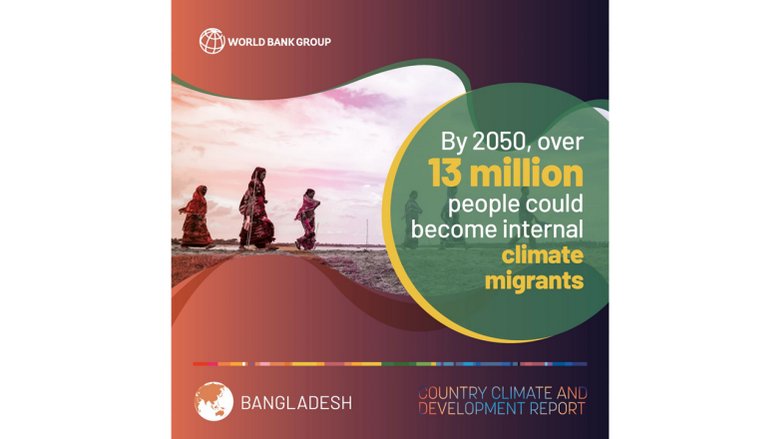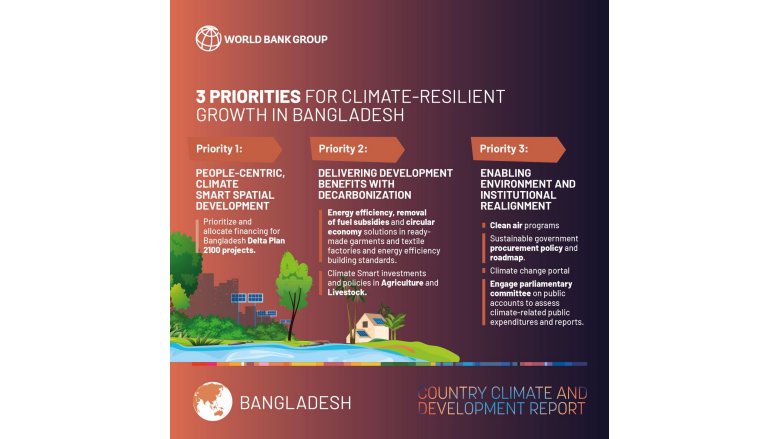Bangladesh has demonstrated global best practices on disaster risk management and is a voice for climate vulnerable countries. Bangladesh was among the first to develop a Climate Change Strategy and Action Plan in 2009, which has become a blueprint for other climate-vulnerable nations. The government has put in place a series of proactive policies and investments that strengthen resilience against climate-related disasters, leveraging community-led action. This has led to the development of coastal embankment systems that protect over 6,000 km of vulnerable coastline and an early warning system for cyclones with more than 76,000 volunteers. But more needs to be done.
Priority Areas for Actions:
The Country Climate and Development Report for Bangladesh outlines priority actions and financing needs to help Bangladesh address the climate crisis. The report highlights three priority areas of action for Bangladesh’s climate resilient growth:
1. People-centric, Climate-smart Spatial Development
Communities exposed to multiple hazards show a substantially lower decrease in poverty, or even poverty increases over time. An approach which recognizes regional variations in climate impacts and builds on Bangladesh’s rich history of locally-led action, is critical. Crop diversification and climate-smart technology is key to support higher agriculture productivity, better climate resilience, and higher incomes in rural areas.
Investment in public services and infrastructure, including shock-responsive social protection, access to quality skills training and jobs, affordable housing, resilient transport connectivity, water and waste management will be key for urban areas especially considering the influx of climate migrants. Investment prioritization and implementation of the government’s Bangladesh Delta Plan 2100 will help achieve long-term development of the country’s delta and river systems and promote sustainable management of water and land resources.
2. Decarbonization of the economy
At just 0.4 percent, Bangladesh’s current contribution to global greenhouse gas (GHG) emissions is not significant. But with its large population and fast economic growth, if the country follows a ‘business-as-usual’ development pathway, GHG emissions will increase substantially.
The report’s analysis suggests that the country can exceed its commitments in the updated 2021 Nationally Determined Contributions (NDC) without compromising development objectives.
Bangladesh also faces a high level of air pollution, which costs about 9 percent of GDP annually. By implementing policies that abate both air pollution and emissions, Bangladesh can reduce deaths from air pollution by half or save nearly 1 million lives within 2030. Emissions can be reduced at relatively low-cost and yield other important benefits, such as the reduction of overall energy costs and increased income. Shifting industries to a more sustainable path will also be vital to their global competitiveness. Removing energy subsidies and domestic protection of inefficient industries will be critical to encourage domestic and foreign investment in energy and resource efficiency.
3. Enabling environment and institutional realignment
An immediate challenge for Bangladesh is to improve legislative and institutional capacity for the efficient implementation of existing policies and programs. Empowering local governments to plan and implement programs for efficient and effective adaptation will be key. Partnerships with civil society NGOs to deliver and monitor climate change programs will be necessary, given their urgency, scale, and complexity. Climate finance from the private sector has the potential to rise to around 0.2 percent of GDP (up to $1 billion) by 2025. Underlying financial sector vulnerabilities need to be addressed together with policies to green the financial sector. Increased domestic and foreign private sector involvement, such as in climate-smart agriculture and renewable energy, is necessary and feasible.



